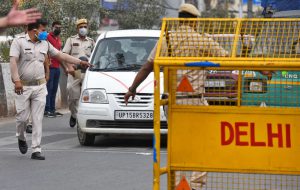MAY 23, 2021

NEW DELHI, INDIA – MAY 10: Delhi Police personnel screening commuters for violations at Seema Puri Border during a Covid-19 curfew on May 10, 2021 in New Delhi, India. In an effort to check the rising Covid-19 cases, Delhi government has extended the lockdown in the national capital for another week till May 17. Delhi Metro services have also been suspended from Monday, the chief minister informed. Delhi has been under a lockdown since April 20 in view of the second Covid-19 wave. (Photo by Raj K Raj/Hindustan Times via Getty Images)
NEW DELHI, INDIA – May is passing by as the month of lockdowns across India. What began with the janata curfew on March 22, 2020 last year, after the beating of pots and pans, followed by the nationwide lockdown spread over several weeks has now come to stay through the summer of 2021 too. Except this year it is being left to the states—they are taking the call on duration as well as the restrictions to be imposed.
Given that the spread of the virus as well as the prophylactic measures–including vaccination–are not uniform across states, the shift in strategy of leaving lockdowns to the discretion of state governments became imperative to minimise the scramble and rush at hospitals. Maharashtra, which at one stage in March-April appeared to be the worst affected, took the lead in imposing the lockdown despite the criticism of the adverse impact on the economy. Thereafter, like a domino effect, others including Delhi and Tamil Nadu followed suit.
Consequently, today most parts of India are enveloped by a wide range of shutdowns. Some states like Andhra Pradesh call it curfew while several others have also imposed a ban on the assembly of five or more persons. Relaxation in the stringent restrictions is mostly for a short while, ranging from just two to six hours in the forenoon, to enable citizens to buy groceries and other essentials. Vaccination centres, banks and other essential services remain functional. The restrictions are however compelling considering the rise in infectivity and the looming geographical spread of the virus. Compounding this are the numerous challenges posed by the humungous vaccination programme due to shortages.
“The lockdown doctrine was pretty hard during the first wave last year when rail and other transport also were fully stopped and people were told to remain indoors. What made it confusing was a concocted view that gained ground initially that the virus will not induce any adaptive immunity and that it is a very dangerous one,” recalls Dr. Jayaprakash Muliyil, renowned epidemiologist and chairman of the scientific advisory committee of the National Institute of Epidemiology. “This led to a nasty situation and poor appreciation of what was implemented then as the lockdown.”
Placing reasonable restrictions on the movement and gathering of people are crucial to check the spread of the virus in the hope that transmission will be arrested. “A lockdown, whatever its form, accompanied with restrictions in different shades of grey, is convenient for the administration. But it is not possible to eliminate the virus with that. Moreover, we have not admitted to community transmission and that most people are infected,” points out Dr Muliyil, adding that “one important rule is once infected pretty immune and re-infection is a rarity given our large population”.
The ability of individuals who are asymptomatic or have mild symptoms to still spread the disease explains why social distancing–limiting contact with others–in addition to other actions such as washing your hands and not touching your face, is so critical. The World Health Organization is starting to refer to it as physical distancing instead to emphasise the importance of being far enough away to avoid infection from the respiratory droplets that carry the virus. It is important that every single person adheres to this, whether or not they think they are sick. Life under lockdown brings many challenges, and there have been many instances of people flouting advice on social distancing or isolation. But the more people abide by it, the more effective it will be.
An advisory, issued by the principal scientific advisor to the Government of India, on May 20, cautions about the need to remember simple measures that could reduce the transmission of the virus. It points out that ventilation is a community defence that protects all and that aerosols could be carried up in the air for up to 10 metres and improving the ventilation of indoor spaces would reduce transmission. It recommended adding outdoor air in offices, homes and public spaces. Droplets and aerosols were the key transmission modes of the virus. While droplets fell up to two metres from an infected person, aerosols could travel up to ten metres.
Meanwhile, academics at the Indian Institute of Science, Bengaluru, who analysed the increase in Covid-19 cases during the lockdown period, say that the lockdown was 80 per cent effective in Karnataka. They recommend the extension of lockdown, as the spread of cases, is continuing and call for a graded unlocking strategy.
However, the most significant gain from these restrictions, Dr. Muliyil says, is in controlling the rush at hospitals. The scramble for hospital beds and oxygen facilities is symptomatic of the uncontrollable rush. It is to stall this, more than anything else, that lockdowns are necessary. On it rests the hope for providing dependable healthcare services and saving lives.
Follow the government’s latest travel advice if you are planning a trip outside India or travelling back to India from affected areas. You can also read World Health Organization’s advice on basic protective measures against the virus. WHO has also busted some myths surrounding coronavirus. The Ministry of Health’s special helpline is available at +91-11-23978046 and ncov2019@gmail.com.
Courtesy/Source: India Today

































































































